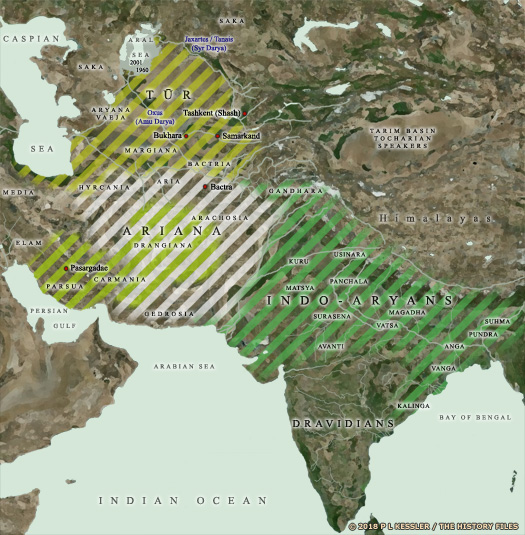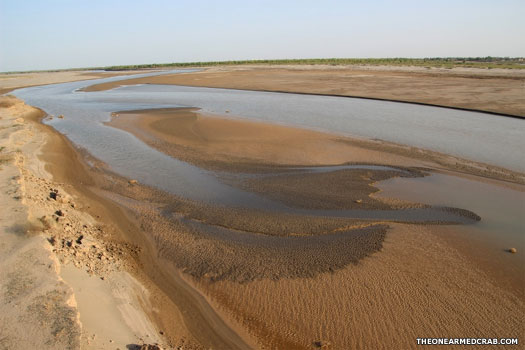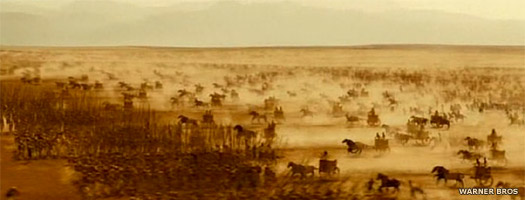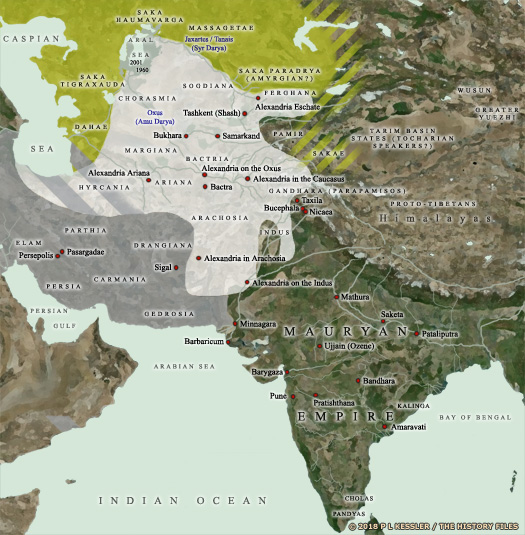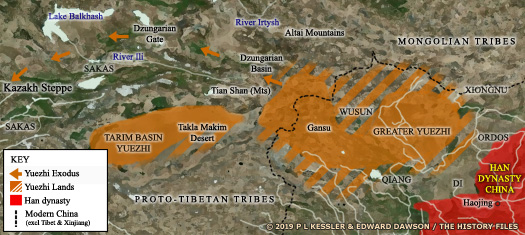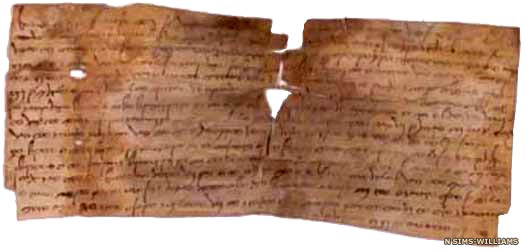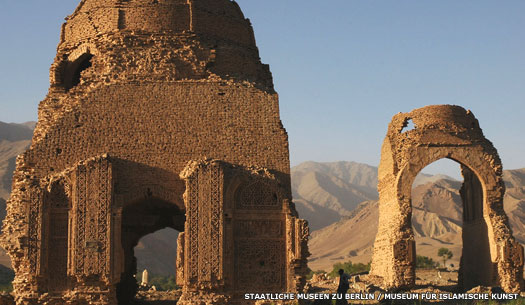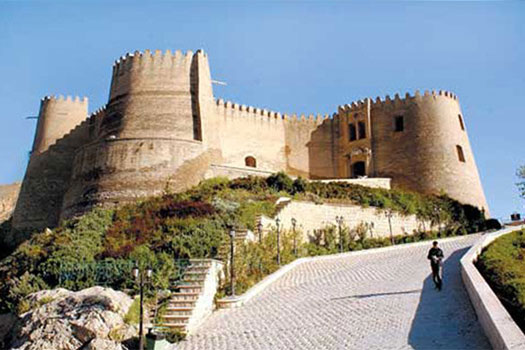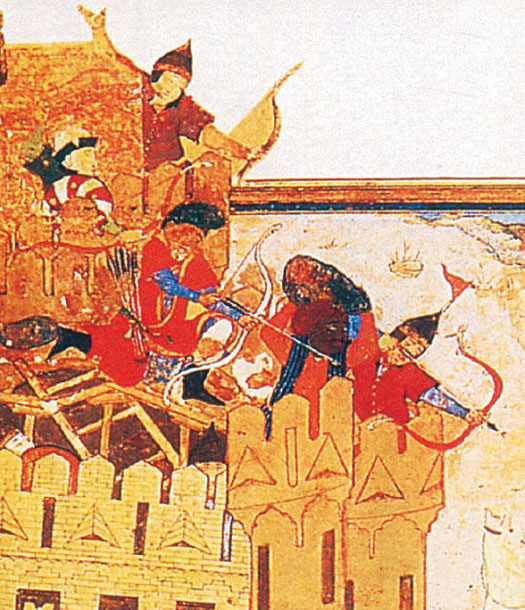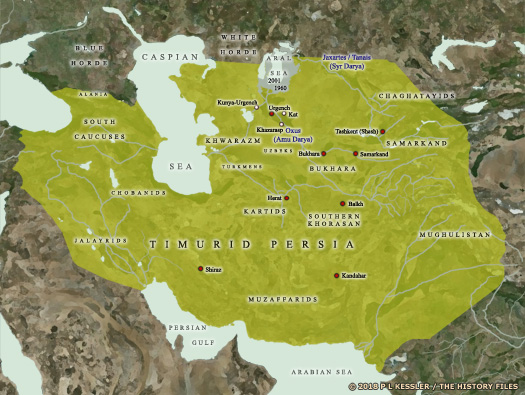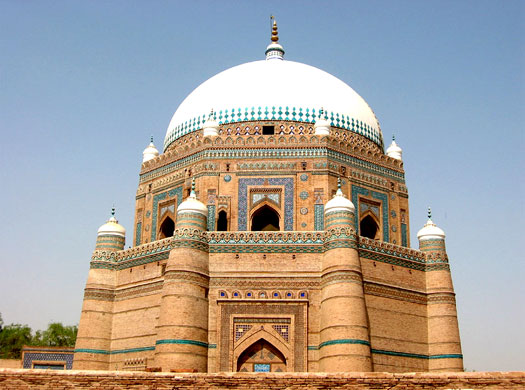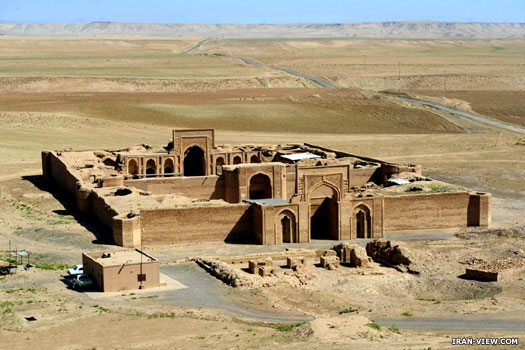
| AREIOI Incorporating the Areioi :
The ancient province of Aria lay largely within the northern areas of modern Afghanistan, southern Turkmenistan, and perhaps the eastern edges of Iran. Within it was included the River Hari, the ancient River Arius, from which the region probably gained its name (river names are generally older than regional or district names). With Aria centred on what is now the city of Herat, the valley of the Arius was famous for its fertile soil and excellent cultivation properties. Prior to its late sixth century BC domination by the Achaemenid Persians, Aria seems to have formed part of a much larger and more poorly-defined region known as Ariana, with the later Aria seemingly lying at its heart. Barely recorded by written history, its precise boundaries are impossible to pin down. It may have encompassed much or all of southern Transoxiana, the region around the River Oxus (the Amu Darya), and could have reached as far south as the coastline of the Arabian Sea.
This region was home to one of the oldest series of states in Central Asia, the indigenous Bactria-Margiana Archaeological Complex, or Oxus Civilisation (otherwise known as the BMAC). As suggested, this was centred on Bactria and Margiana, but it extended into the neighbouring (Persian and Greek) provinces and regions of Paropamisadae (to the south-east), Arachosia (to the south), Carmania (to the south-west), and Hyrcania (to the west). East Indo-European tribes soon integrated into the area from the steppelands to the north, creating a melting pot which formed the Indo-Iranian tribes. From there, following the civilisation's collapse by around 1700 BC, they migrated outwards, westwards into pre-Achaemenid Iran as the Alani, Mannaeans, Medians (or Medes), and Parsua, and eastwards into India. Those who remained behind appear to have entered the historical record around the sixth century BC, when they came up against the rapidly expanding Persian empire.
The name is a variation of Arya, usually shown as Aria (Latin), Areia (close to the Greek spelling), Haraiva (Persian), or Haraeuua (Avestan). The Areioi (or Arii) tribe mentioned by Herodotus which occupied the Persian and Greek province of Haraiva/Aria were named on the same basis (he also mentions that the Medes were formerly called the Arioi - Aryans) - as is the River Hari. Although it is unfashionable to use it these days, thanks to the Nazis, the name Arya appears to be the oldest one known for Indo-Europeans (IEs). Both Iranians and Indians derived from a single group which are usually called either Indo-Iranians or Indo-Aryans and which were descended from East IE groups. They probably knew themselves as Arya plus a plural suffix, possibly '-na', producing Aryana. Apart from being preserved in the eponymous province, this was also retained in names such as Iran (Aryan), the prefix of a line of kings in Cappadocia, Satrap Ariobarzanes of Persis, the duchy of Ariano in Italy, and many others. It does not seem to have been retained amongst Celtic names, but if it can be found amongst the Celto-Italics and Slavics then it may be the case that it was the actual name of the original IE homeland or a major sub-grouping of IE tribes.
The term 'Ariana' was used by various ancient writers as a general geographical term which covered the later provinces of Aria, Carmania, Gedrosia, Drangiana, Arachosia, Gandhar (part), and Bactria (part). This would appear to correspond relatively closely to the modern borders of Afghanistan and Pakistan. Curiously, and perhaps not at all coincidentally, the land of Tūr (or Turaj, sometimes also shown without the accented 'u' as Tur) which is mentioned in Persian sources seems to border this to the north. The land of Tūr, which contained the kingdom of Turan, can be equated to territory in the heartland of Indo-Iranian southern Central Asia and South Asia, focused mainly on the later provinces of Bactria and Margiana, and extending into Sogdiana. The focus in Tūr seems largely to have been westwards, along the migratory trail used by Alani, Mannaeans, Medes, and Persians to reach the Zagros Mountains or southern Iran. The land of Aryana Vaejah mentioned in the Avesta is usually located to the north and west of both lands.
The focus in Ariana is less clear, but the region was the gateway into India so, even prior to Alexander's campaigns through this land and into the northern Indus and southern Indus, the focus was probably eastwards. If Central Asia was, as it seems to be, the melting pot which created the Indo-Iranian and Indo-Aryan groups, then if Tūr was the Indo-Iranian heartland, could Ariana have been the Indo-Aryan opposite number? The migration of Indo-Aryans into India would have come through this region, so it's not an impossibility that the migration started from Ariana, perhaps after a period of relatively settled life here following the BMAC decline. This is speculation, of course, but highly interesting nonetheless.
(Additional information by Edward Dawson, from The Persian Empire, J M Cook (1983), from the Dictionary of Greek and Roman Geography: 'Ariana', William Smith (Boston, 1980), from The Histories, Herodotus (Penguin, 1996), and from External Links: The Geography of Strabo (Loeb ical Library Edition, 1932), and Encyclopaedia Iranica.)
8th century BC :
Later myth ascribes a dynasty of Indo-Iranian rulers to this period, as described in the Shahnameh (The Book of Kings), a poetic opus which is written about AD 1000 but which accesses older works (such as the semi-official seventh century AD book called the Kwaday-namag), and perhaps elements of an oral tradition. The Kayanian dynasty of kings of the Persians are also the heroes of the Avesta, which forms the sacred texts of Zoroastrianism.
The earliest of these mythical Indo-Iranian rulers is Fereydun, king of a 'world empire'. His subjects are the Indo-Iranian tribes of the region while his kingdom is apparently in the land of Tūr. This can be equated to territory in the heartland of Indo-Iranian southern Central Asia and South Asia, focused mainly on the later provinces of Bactria and Margiana, along with the Kopet Dag region (a mountain range which serves to separate modern Turkmenistan and Iran), the Atrek valley, and the eastern Alborz Mountains.
Judging by those borders, the land of Tūr stretches from Samarkand to Tehran, although the kingdom of Turan is probably a good deal smaller and more eastern-based. The Persians themselves may still control a good deal of the western section as they began to settle in southern Iran. Curiously (and probably not coincidentally), these borders place the land of Tūr on the northern border of another ancient region, that of Ariana.
Following the climate-change-induced collapse of indigenous civilisations and cultures in Iran and Central Asia between about 2200-1700 BC, Indo-Iranian groups gradually migrated southwards to form two regions - Tūr (yellow) and Ariana (white), with westward migrants forming the early Parsua kingdom (lime green), and Indo-Aryans entering India (green) c.546 - 540 BC :
The defeat of the Medes opens the floodgates for Cyrus the Great with a wave of conquests, beginning in the west from 549 BC but focussing towards the east of the Persians from about 546 BC. Eastern Iran falls during a more drawn-out campaign between about 546-540 BC, which may be when Maka is taken (presumed to be the southern coastal strip of the Arabian Sea). Further eastern regions now fall, namely Arachosia, Aria, Bactria, Carmania, Chorasmia, Drangiana, Gandhar, Gedrosia, Hyrcania, Margiana, Parthia, Saka (at least part of the broad tribal lands of the Sakas), Sogdiana (with Ferghana), and Thatagush - all added to the empire, although records for these campaigns are characteristically sparse.
Persian Satraps of Haraiva (Aria) :
Conquered in the mid-sixth century BC by Cyrus the Great, the region of Haraiva (or Haraiwa) was added to the Persian empire. The name is also known in Avestan as Haraēuua. Before the Persians took control it was populated largely by Indo-Iranian tribal groups, and especially by a tribe known as the Areioi. Under the Persians it was formed into an official satrapy or province which was focused on the River Hari and its fertile valley soil. According to the Behistun inscription of Darius the Great it was known as Haraiva (the Persian variation of the tribal and river name - Aria is a Greek mangling of this version of the name).
These eastern regions of the new-found empire were ancestral homelands for the Persians. They formed the Indo-Iranian melting pot from which the Parsua had migrated west in the first place to reach Persis. There would have been no language barriers for Cyrus' forces and few cultural differences. Although details of his conquests are relatively poor, he seemingly experienced few problems in uniting the various tribes under his governance. He was the first to exert any form of imperial control here, although his campaign may have been driven partially by a desire to recreate the semi-mythical kingdom of Turan in the land of Tūr, but now under Persian control. Curiously the Persians had little knowledge of what lay to the north of their eastern empire, with the result that Alexander the Great was less well-informed about the region than earlier Ionian settlers on the Black Sea coast had been.
Various Persian royal inscriptions list the provinces of the eastern empire or depict local representatives. Those of Haraiva are shown wearing Scythian-style dress which includes a tunic over trousers which are tucked into high boots. The twisted turban in the head provides the final touch, and perhaps all the proof that is needed that these were an Indo-Iranian people with close links to the Indo-Europeans of the Pontic-Caspian steppe. Strabo describes Haraiva's territory, which seems to be pretty close to the modern Herat Province of Afghanistan. The province of Harahuwatish (Arachosia) lay to the south of the mountains that enclosed Aria (Strabo). The capital was at Artacoana, which has also been shown as Artacana, Artacaena, Articaudna, or Chortacana by various ancient authors, Roman and Greek.
(Information by Peter Kessler, with additional information from Geography, Ptolemy, from Bibliotheca Historica, Diodorus Siculus, from Historiae Alexandri Magni, Quintus Curtius Rufus, from Anabasis Alexandri, Arrian of Nicomedia, from The Persian Empire, J M Cook (1983), from The Histories, Herodotus (Penguin, 1996), and from External Links: The Geography of Strabo (Loeb ical Library Edition, 1932), and The Natural History, Pliny the Elder (John Bostock, Ed), and Encyclopaedia Iranica.)
516 - 515 BC :
Achaemenid ruler Darius embarks on a military campaign into the lands east of the empire. He marches through Aria and Bakhtrish, and then to Gadara and Taxila. By 515 BC he is conquering lands around the Indus Valley to incorporate into the new satrapy of Hindush before returning via Harahuwatish and Zranka. Along the way the Sakas are largely defeated and conquered.
The River Oxus - also known over the course of many centuries as the Amu Darya - was used as a demarcation border throughout history and was also a hub of activity in prehistoric times - but during this period it flowed right through the heart of the region that was known as Bactria fl 480 BC :
Sisamnes : Persian satrap. Son of the Hydarnes of Darius' 522 BC coup.
c.480 BC :
Sisamnes is a son of Hydarnes I, one of the seven co-conspirators, along with soon-to-be Achaemenid ruler, Darius the Great, who had been responsible for removing the 'usurper' Gaumata from the throne in 522 BC. Darius had since treated his colleagues as family, and Hydarnes' appointment as satrap of Media is one of the empire's plum jobs.
360s/350s BC :
Artaxerxes II is occupied fighting the 'revolt of the satraps' in the western part of the empire. Nothing is known of events in the eastern half of the Persian empire at this time, but no word of unrest is mentioned by Greek writers, however briefly. Given the newsworthiness for Greeks of any rebellion against the Persian king, this should be enough to show that the east remains solidly behind the king. It seems that all of the empire's troubles hinge on the Greeks during this period.
? - 330 BC :
Satibarzanes : Persian satrap. One of the three highest-ranked in the east.
330 - 328 BC : Satibarzanes is one of the three most senior satraps of the east, the others being Bessus in Bakhtrish and Barsaentes of Harahuwatish. In 330-329 BC, despite the best efforts of Bessus to rally supporters to his defence of the empire, the Persian provinces of the east are conquered by the Greek empire under Alexander the Great. too.
Alexander defeated the Persian king Darius III at the Battle of Gaugamela in Mesopotamia in 331 BC, with the victory giving him control of all the lands to the west of Iran - the lands to the east soon followed In the case of Haraiva, Satibarzanes submits to Alexander and is allowed to retain office. Alexander leaves a garrison of forty horsemen in the capital, Artacoana, so that Macedonian troops who are following on behind him do not reopen hostilities. Satibarzanes has them murdered, excites the province into a state of rebellion, and orders his forces to defend Artacoana. When Alexander returns, however, he flees to join Bessus and the city is taken after a short siege. Satibarzanes is slain soon afterwards when attempting to lead reinforcements back into Aria.
Argead Dynasty in Aria :
The Argead were the ruling family and founders of Macedonia who reached their greatest extent under Alexander the Great and his two successors before the kingdom broke up into several Hellenic sections. Following Alexander's conquest of central and eastern Persia in 331-328 BC, the Greek empire ruled the region until Alexander's death in 323 BC and the subsequent regency period which ended in 310 BC. Alexander's successors held no real power, being mere figureheads for the generals who really held control of Alexander's empire. Following that latter period and during the course of several wars, Aria was left in the hands of the Seleucid empire from 305 BC.
The former Persian satrapy of Haraiva retained its borders under the Greeks. They pronounced the name differently - as Aria or Areia - and some writers confused it with the ancient region of Ariana. The regional capital of Artacoana, largely destroyed during the siege to take it from the Persian satrap, Satibarzanes, was replaced by a new city, built at an unknown point after the Greek conquest but probably earlier rather than later. This was named Alexandria Ariana or Arion, although it most likely either began as a fortress with a few dwellings springing up alongside it, or was a renamed and repaired existing city - Alexander's time in Aria was brief after all. In time it became better known to modern audiences as Herat in what is now north-western Afghanistan. The satrapy was also home to a large number of other cities (or rather, large towns in the more modern sense of what constitutes a city). Aria was a rich province situated in rich farming territory, so cities such as Aria Civitas, Astasana, Paracanacź, and Susia flourished.
(Information by Peter Kessler, with additional information from Geography, Ptolemy, from Bibliotheca Historica, Diodorus Siculus, from Historiae Alexandri Magni, Quintus Curtius Rufus, from A Dictionary of Greek and Roman Biography and Mythology, William Smith (London, 1873), from Anabasis Alexandri, Arrian of Nicomedia, from The Persian Empire, J M Cook (1983), from The Histories, Herodotus (Penguin, 1996), and from External Links: The Geography of Strabo (Loeb ical Library Edition, 1932), and The Natural History, Pliny the Elder (John Bostock, Ed), and Encyclopaedia Iranica.)
330 - 323 BC :
Alexander III the Great : King of Macedonia. Conquered Persia.
323 - 317 BC :
Philip III Arrhidaeus : Feeble-minded half-brother of Alexander the Great.
317 - 310 BC :
Alexander IV of Macedonia : Infant son of Alexander the Great and Roxana.
330 - 323 BC :
Arsames : Greek satrap of Aria & Drangiana. Arrested by Stasanor.
323 - 321 BC :
Stasanor the Solian : Greek satrap of Aria & Drangiana. Gained Bactria in 321 BC.
321 - 315 BC :
Stasander the Solian : Greek satrap of Aria & Drangiana (brother of Stanasor).
321 BC :
Stasander the Solian is brother to Stasanor, now satrap of Bactria, Chorasmia, and Sogdiana. Perhaps the brother also has more of a focus towards the Northern Indus territories than the eastern coast of the Caspian Sea, as suggested by later events. His territory initially extends as far north as Ferghana, which contains the city of Alexandria Eschate ('the Furthest'), while Stasander also has ambitions.
The route of Alexander's ongoing campaigns are shown in this map, with them leading him from Europe to Egypt, into Persia, and across the vastness of eastern Iran as far as the Pamir mountain range 316 - 315 BC :
The Wars of the Diadochi decide how Alexander the Great's empire is carved up between his generals, but the period is very confused, especially in the east. These provinces appear to be invaded and controlled by the Antigonids for a period, with General Antigonus being responsible for the death of Eudamus. However, at some point in 316 BC, Stasanor the Solian, satrap of Chorasmia, Bactria, and Sogdiana (with Ferghana) seizes the Northern Indus while his brother seizes Parthia. Clearly the two are either working in unison with Seleucus of Babylonia from the beginning or are attempting to stamp their own independent authority on much of the east.
315 - 312 BC :
Eumenes is defeated in Asia and is murdered by his own troops, and Seleucus is forced to flee Babylon by Antigonus. The result is that Cassander controls the European territories (including Macedonia), while the Empire of Antigonus controls those in Asia (Asia Minor, centred on Phrygia and extending as far as Susiana), and also temporarily some of the eastern territories, including Aria, Drangiana, and Parthia, where Stasander is removed from office and replaced by Euitus.
315 - 312? BC :
Euitus : Greek satrap of Aria, Drangiana, & Parthia for Antigonus.
312 - 306 BC :
Bactria is taken by the Seleucids around 312 BC. Aria would also seem to fall to them at the same time, given its immediacy to Bactria. It remains a Seleucid possession until Bactria becomes independent in the third century BC.
Macedonian & Parthian Aria :
Once safely under Seleucid control after the conclusion of the Greek Wars of the Diadochi, Aria was governed by Macedonian satraps under the authority of the Seleucid empire which commanded from Babylonia and Syria. The creator of this empire, Seleucus himself, was able to expand his holdings with some ruthlessness, building up his stock of Alexander's far eastern regions as far as the borders of India and the River Indus (Sindh). Appian's work, The Syrian Wars, provides a detailed list of these regions, which included Arabia, Arachosia, Aria, Armenia, Bactria, 'Seleucid' Cappadocia (as it was known) by 301 BC, Carmania, Cilicia (eventually), Drangiana, Gedrosia, Hyrcania, Media, Mesopotamia, Paropamisadae, Parthia, Persia, Sogdiana, and Tapouria (a small satrapy beyond Hyrcania), plus eastern areas of Phrygia.
Farther east, the descendants of some of the original satraps became independent kings, after Bactria had been cut off from the Seleucids by Parthian incursion into central Persia. Aria was part of this independent kingdom as it too had been cut off from the west, but it was subsumed within the growing Parthian empire in 167 BC. In the following years, Aria (which is now located in north-western Afghanistan) became a frontier area between the Parthian empire to the west and the territories of the Greco-Bactrians to the east. The fall of the Greco-Bactrians to the Greater Yuezhi allowed Scythian incursions from the north to penetrate much of Aria.
(Information by David Kelleher and Peter Kessler, from Epitome of the Philippic History of Pompeius Trogus: Books 11-12, Volume 1, Marcus Junianus Justinus, John Yardley, & Waldemar Heckel, from Nomadism in Iran: From Antiquity to the Modern Era, Daniel T Potts (Oxford University Press, 2014), and from External Links: the Ancient History Encyclopaedia (dead link), and Encyclopędia Britannica, and Ancient History Encyclopaedia, and Encyclopaedia Iranica, and Appian's History of Rome: The Syrian Wars at Livius.org. Where information conflicts regarding the Indo-Greek territories, Osmund Bopearachchi's Monnaies Gréco-Bactriennes et Indo-Grecques, Catalogue Raisonné (1991) has been followed.)
c.235/230 BC :
Diodotus II of Bactria is overthrown by Euthydemus, possibly the satrap of Sogdiana. The date is uncertain and Strabo puts forward 223/221 BC as an alternative, placing it within a period of internal Seleucid discord.
235 - 200/195 BC :
Euthydemus I Theos : Satrap of Sogdiana? Founder of the Euthydemids of Bactria.
c.220 BC :
The realm of Euthydemus of Bactria is a large one, including Sogdiana and Ferghana to the north, and Margiana and Aria to the west. There are indications that from Alexandria Eschate in Ferghana the Greco-Bactrians may lead expeditions as far as Kashgar (a little under three hundred and twenty kilometres (two hundred miles) due east of Ferghana), and Urumqi in Chinese Turkestan. There they would be able to establish the first known contacts between China and Europeans around 220 BC.
The kingdom of Bactria (shown in white) was at the height of its power around 200-180 BC, with fresh conquests being made in the south-east, encroaching into India just as the Mauryan empire was on the verge of collapse, while around the northern and eastern borders dwelt various tribes that would eventually contribute to the downfall of the Greeks - the Sakas and Greater Yuezhi Even more remarkably, recent examinations of the 'Terracotta Army' have established a startling new concept - the terracotta army may be the product of western art forms and technology. An entire terracotta army plus imperial court are manufactured using five workshops and a form of human representation in sculpture that has never before been seen in China. Archaeologists today continue the process of discovering new pits and even a fan of roads leading out from the emperor's burial mound, one of which, heading west, may be a sort of proto-Silk Road along which Greek craftsmen may be travelling.
167 BC :
Under Mithradates the Parthians rise from obscurity to become a major regional power, although a precise chronology is not possible. Having consolidated their power, their first expansion takes the former province of Aria from the Greco-Bactrian kingdom. It seems possible that Aria (and possibly a rebellious Drangiana too) had already been conquered once by the Arsacids, with the Greco-Bactrians recapturing it, probably during the reign of Euthydemus I Theos. During the reign of Eucratides I the Greco-Bactrians are also engaged in warfare against the people of Sogdiana, showing that they have lost control of that northern region too (and by inference Ferghana).
The other eastern provinces, all of which still appear to be in Seleucid hands, must also fall to the Parthians very quickly after this - including Carmania, Gedrosia, and Margiana - although firm evidence to show a specific date appears to be lacking. Another date which may be valid for these losses is 185 BC, when Seleucus IV loses eastern Iran to Parthian expansion, but the fact that the Parthians fail to expand out of their initial conquests until Mithradates accedes makes this period a more likely one.
c.165 BC :
Defeated by the Xiongnu, the Greater Yuezhi are forced to evacuate their lands on the borders of the Chinese kingdom. They begin a migration westwards that triggers a slow domino effect of barbarian movement.
The Greater Yuezhi were defeated and forced out of the Gansu region by the Xiongnu, and their migratory route into Central Asia is pretty easy to deduct from the fact that they chose to try and settle in the Ili river valley below Lake Balkhash 115 - 100 BC :
With Parthian territory having been harried for years by the Sakas, King Mithridates II is finally able to take control of the situation. First he defeats the Greater Yuezhi in Sogdiana in 115 BC, and then he defeats the Sakas in Parthia and Seistan (in Drangiana) around 100 BC. After their defeat, the Greater Yuezhi tribes concentrate on consolidation in Bactria-Tokharistan while the Sakas are diverted into Indo-Greek Gandhar. The western territories of Aria, Drangiana, and Margiana would appear to remain Parthian dependencies, albeit with Aria falling to the Kushans towards the end of the second century. Although Carmania does not seem to be mentioned directly, its position between Drangiana and Persia would make it likely that this too is still in Parthian hands.
The situation in Aria would seem to settle down after this period of uncertainty and strife. Aria is seemingly not mentioned again, even obliquely, until the third century AD. During this time it apparently remains part of the Kushan empire albeit, probably, as a frontier zone. The decline of the Parthians in the first two centuries AD would probably aid in this until the Kushan empire itself declines in the face of Sassanid expansionism.
c.AD 230 - 250 :
The end of Kushan King Vasudeva's reign in AD 207 apparently coincides with the beginning of the Sassanid invasion of north-western India, although the dating for the main invasion fits with Vashiska and his successor around 230-250. Perhaps there is a first, preliminary invasion followed by a much greater second.
The Kushans are toppled in former Arachosia, Aria, and Bactria-Tokharistan, and are forced to accept Sassanid suzerainty. They are replaced in positions of authority by Sassanid vassals known as the Kushanshahs or Indo-Sassanids. There is a split in Kushan rule, so that a separate, eastern section rules independent of the Sassanids, while some of the nobility remain in the west as Sassanid vassals. Even so, Kushan power still gradually wanes in India. Aria now becomes better known by an altered form of its Old Persian name - Harev.
325 :
With Peroz II of the Kushanshahs beginning to pull away from Sassanid control, the Persian ruler Shapur II divides the realm, assuming direct control of the southern areas of what is now Afghanistan (and also Merv in modern Turkmenistan, Herat in Aria, and then Gandhar), while the Kushanshahs continue to rule in the north. With events in the east frequently being poorly documented, there is some doubt about the identity of the Shapur who carries this out. It is probably Shapur II, but it may instead be a governor, or even Shapur's older brother, who bears the same name.
A Kushanshah letter addressed to their mid-fourth century AD ruler, Varhran, from the daughter of a princess named Dukht-anosh, a Middle Persian name 484 :
Peroz again chases the Hephthalites out of Bactra and towards Arion in Aria (Alexandria Ariana, modern Herat). Along the way he destroys the tower built by Bahram V which marks the border between Sassanid and Hephthalite. On the other side of the border, Khushnavaz sets a trap into which Peroz falls (literally), along with around thirty of his sons and about 100,000 troops. Their bodies are never recovered by the Sassanids. The eastern empire is overrun and is largely occupied by the Hephthalites until their final fall - this includes regions such as Margiana, with the Hephthalites setting up puppet governors there. In Kabulistan and Zabulistan the Nezak are able to create their own semi-independent dynasty.
587/588 :
Nestorian (Christian) bishops from Harev travel to the Sassanid capital of Ctesiphon to attend the synod of Ishoyahb I (during the reign of Sassanid King Hormizd IV). In the same year, Harev is invaded by Bagha İşbara of the eastern Göktürks (who is known as āwa, Sāva (Sava), or Sāba (Saba) in medieval Iranian sources). His forces are exaggerated to 300,000 men but he is defeated and killed by Hormizd IV's military commander, Bahram Chobin.
651 - 652 :
The death of Sassanid King Yazdagird III is the prompt needed for Nezak Tarkhan, the Hephthalite ruler of Badghis (now in north-western Afghanistan) to take control of Harev. Just a year later the Arab invasion snatches it away from him. Harev is now part of the Islamic empire.
Islamic Aria (Harev) :
For some centuries, Aria served as a frontier region between the Parthians and the Bactrians, and then the Parthians and Scythians (in the form of the Sakas). The Sassanids seemingly had better control of it, with Harev serving as a provincial capital with a mint. In the later Sassanid years, Aria became strategically important in the fight against the Xionites and Hephthalites. Information covering this period is exceptionally poor, as it always seems to be in the eastern parts of Iran's various large empires during times of stress and strife. It took until the fall of the Sassanids for the Hephthalites to take Harev, and then they only held it for a year before the Arab invasion swept through the region.
Following the Islamic conquest of Sassanid Persia in 651 and then its eastern territories in Transoxiana, governors were put in place to command this great, tumultuous region. Rather than maintain a series of minor provinces which had existed in one form or another since the initial Achaemenid conquest of the east under Cyrus the Great, it would seem that the province of Chorasmia was now greatly enlarged, becoming known as Greater Khorasan (although something of this reorganisation may already have taken place under the Sassanids). This included many of the old provinces within its territory, Aria and Margiana being two of them. To govern the region, emirs were appointed by the caliph in Syria during the seventh century.
By this time, the region's old Indo-Iranian name, Haraiva (Aria was the Greek form of this) had been adapted into the Middle Persian Harev or Harey. Under this banner it was first described in Sassanid King Shapur I's third century AD inscription on the Ka'ba-ye Zartosht stone chamber and tower in Marvdasht (Iran). It was under his rule that the town of Pushang (Bushanj or Fūshanj) was established close to the region's eponymous capital city. That capital, Harev, is better known today as the city of Herat.
(Information by Peter Kessler, with additional information by Abhijit Rajadhyaksha and Edward Dawson, from Timurids, The Columbia Encyclopaedia (Sixth Ed, Columbia University), from The Encyclopaedia of War: Timur ('the Lame') (1336-1405), Timothy May, from The Art of War: Great Commanders of the Ancient and Medieval World: Tamerlane, Justin Marozzi (Andrew Roberts, Ed, Quercus Military History, 2008), from Tamerlane and the symbolism of sovereignty, Beatrice Forbes Manz (Iranian Studies 21 (1-2), 1988), from The Secret History of Iran, Hamad Subani, from E J Brill's First Encyclopaedia of Islam 1913-1936, Martijn Theodoor Houtsma (Brill, 1987), and from External Links: Zoroastrian Heritage, and The Silk Road, and Encyclopaedia Britannica: Timur, and Encyclopaedia Iranica.)
821 :
The Tahirid emirs are established in Khorasan, which includes what is now northern and western Afghanistan up to the borders of the kingdom of Zabulistan, when the region is granted to them by the Abbasid caliph, al-Mamun.
865 - 873 :
Having already secured his capital of Zaranj at the heart of his small kingdom, Yaghub expands his new Saffarid emirate eastwards to capture al-Rukhkhadj and Zamindawar followed by Zunbil and Kabul by 865. Some of his conquests even further east, towards Balk, encompass non-Islamic tribal chiefdoms. Harev (Herat) is taken in 870. Then he expands his borders greatly in 873 by ousting Emir Muhammad of the Tahirids. Khorasan is captured, giving the Saffarids a great swathe of new territory.
As Haraiva, Harev, and Herat the city and its surrounding lands have served many masters and has undergone periods of flourishing fortunes and turbulent destruction 1017 - 1040 :
Khwarazm is conquered by Yamin-ud-Dawlah Mahmud from his Ghaznavid base in Southern Khorasan after the emir of Khwarazm is killed in a rebellion, but it is unclear if the entire emirate is subjugated. In 1040 the Ghaznavids are defeated by Seljuq Turkic at Dandanqan, and lose their western territories, including Khwarazm.
1220 - 1221 :
After the shah of Khwarazm decapitates the Mongol ambassador from Chingiz Khan, the emirate is attacked twice by Chingiz Khan and the Golden Horde, along with Ghurid Afghanistan. Khwarazm is reduced to its western section covering northern Mesopotamia and western Persia. Bukhara and then Samarkand are captured by the Mongols and chaos results, with thousands being massacred or sold into slavery. Ala ad Deen flees west and dies a fugitive while areas of central Khwarazm (Khorasan) around Herat are seized by the Ghurids and then governed by their subjects, the Kartids.
Kartid
Maliks of Herat :
The Kartids (otherwise known as the Karts or Kurts) were Sunni Muslim Tajiks. Related to Ghurid Sultan Abu'l-Fath Muhammad Shams ad-Din (1163-1203), they secured power in Herat in 1245 as Ghurid subjects during the chaos engendered by the Mongol destruction of mighty Khwarazm in 1220-1221. The Ghurids had already seized areas of Khwarazm's territory after 1221,making it easy for the Kartids to establish Herat as their capital. Their territory soon covered areas of central Khorasan, especially the region that had once been known as Haraiva.
After taking Herat they immediately submitted to the Mongol great khan and were accepted as the city's governors. They remained subjects of the Mongol splinter rulers of Iran and southern Central Asia, the Il-Khans, until they collapsed after 1335. It was Mu'izz-uddin Husayn ibn Ghiyath-uddin, Kartid malik from 1332, who sought to expand his territory at the expense of the Il-Khans and his neighbours. The invasion of the entire region by Tīmūr-i Lang (Tamerlane) in the 1380s ended all local territorial ambitions during this conqueror's lifetime and the Kartids were broken.
(Information by Peter Kessler, with additional information by Abhijit Rajadhyaksha and Edward Dawson, from Timurids, The Columbia Encyclopaedia (Sixth Ed, Columbia University), from The Encyclopaedia of War: Timur ('the Lame') (1336-1405), Timothy May, from The Art of War: Great Commanders of the Ancient and Medieval World: Tamerlane, Justin Marozzi (Andrew Roberts, Ed, Quercus Military History, 2008), from Tamerlane and the symbolism of sovereignty, Beatrice Forbes Manz (Iranian Studies 21 (1-2), 1988), from The Secret History of Iran, Hamad Subani, from E J Brill's First Encyclopaedia of Islam 1913-1936, Martijn Theodoor Houtsma (Brill, 1987), and from External Links: Zoroastrian Heritage, and The Silk Road, and Encyclopaedia Britannica: Timur, and Encyclopaedia Iranica.)
? - 1245 :
Rukn-uddin Abu Bakr : Dynasty founder and Ghurid subject malik in Khorasan.
1245 - 1277 :
Shams-uddin Muhammad bin Abu Bakr : Son. Seized Herat as a Ghurid subject. Submitted to Mongols.
1245 :
Almost immediately after he has succeeded his father as malik, Shams-uddin seizes Herat during an unstable period of Mongol domination. Doing so as a Ghurid subject, he submits to the Mongols and is accepted as their governor of the city and its surroundings.
Herat's citadel, known as the Qala Ikhtyaruddin or the 'Citadel of Alexander', was founded in 330 BC, although it has been destroyed and rebuilt many times since then 1253 - 1255 :
The town of Nih in western Seistan is besieged by Negüder for the Mongols. The Mihrabanid malik, Shamsuddin Ali II, leads an army to the defence of Nih and Negüder is defeated. A rebellion breaks out in Mihrabanid Seistan in 1255, while he is campaigning in northern Baluchistan, and the Kartid malik of Herat, Shams-uddin, immediately makes the most of the situation by capturing the city himself. Shamsuddin Ali is killed by the rebels, leaving Seistan in the hands of the Kartids until Nasruddin can recapture it in 1261.
1277 - 1295 :
Rukn-uddin ibn Sham-suddin Muhammad : Son. Mongol subject until 1289.
1289 :
The Mihrabanids complete their conquest of Quhistan and the Kartid malik of Herat. Nasruddin, appoints his son, Shams al-Din, as governor of Herat (seemingly with the Kartids as his underlings). There are times when Shams al-Din must be supported militarily when it comes to holding onto the city, but overall the conquest proves a successful one.
1295 - 1308 :
Fakhr-uddin ibn Rukn-uddin : Son. Mihrabanid subject.
1308 - 1329 :
Ghiyath-uddin ibn Rukn-uddin : Brother. Mihrabanid subject.
1329 - 1330 :
Shams-uddin ibn Ghiyath-uddin : Son. Mihrabanid subject.
1330 - 1332 :
Hafiz ibn Ghiyath-uddin : Brother. Mihrabanid subject. Murdered.
1332 - 1370 :
Mu'izz-uddin Husayn ibn Ghiyath-uddin : Brother. Mihrabanid subject? Became sultan in 1349.
1335 :
Abu Said Ala ad Dunya wa dDin is the last of the Il-Khans to be descended from Hulegu, the first Il-Khan ruler in 1256. His death in 1335 (or 1336) weakens the khanate, but the same date is sometimes used to mark the birth of a Turkic-Mongol by the name of Tīmūr-i Lang (Tamerlane). This Chaghatayid prince will one day attempt to reform the Mongol empire as a Timurid possession, although his birth most likely takes place in the late 1320s.
1363 :
The attempts by Tughlugh Temur, Chaghatayid khan of Mughulistan, to quell the tribes of Transoxiana are eventually unsuccessful, despite two invasions of the region. His death ends Chaghatayid hopes of restoring control of western Mughulistan. Instead, two tribal leaders contest for control of Transoxiana. Tīmūr-i Lang (Timur) is ultimately successful, taking Transoxiana and Khorasan in the name of the khanate, but effectively forming his own Timurid khanate.
Timurid troops included people from all over his conquered territories, including Turks, Persians, and Indo-Iranian Central Asians, all of whom were organised into a decimal system of units 1369 - 1394 :
Much of Southern Khorasan (modern Afghanistan) is territory which belongs to the Timurid empire, initially under the control of Timur himself, and then under his successors, with regional governors in place to provide day-to-day administration. Timur is accepted as ruler of Balkh, north of Afghanistan, in 1370, and all of the territory which makes up modern Afghanistan is conquered by 1394.
1370 - 1389 :
Ghiyas-uddin Pir 'Ali : Son. Became sultan. Timurid subject from 1383.
1370 - 1389 :
Malik Muhammad ibn Mu'izz-uddin : Brother. Co-ruler.
1382 - 1383 :
Having secured his conquests around Transoxiana, Timur has begun the expansion of his territory into Southern Khorasan and Persia. He forces the Kartids into submission and demands a hostage from Seistan to symbolise the subservience of the Mihrabanids. Although the Kartids are retained for a short time, the region is now very much part of Timurid Khorasan.
Timurid
Khorasan (at Herat) :
The great eastern imperial lands of Persia were the location for a long period of unrest between about 1336-1387. This was while the surviving Il-Khans were being used as puppets by the Chobanids and the Jalayirids for the right to claim control of all of Persia. The Chaghatayid khans of Mughulistan attempted to quell the tribes of Transoxiana but were eventually unsuccessful, despite two invasions of the region in the 1360s. The death of the khan ended Chaghatayid hopes of restoring control of western Mughulistan which included Transoxiana. Instead, two tribal leaders, Amir Husayn and Tīmūr-i Lang (Timur) contested for control of that region.
From 1363, Timur began to conquer large areas of Transoxiana and Khorasan, supposedly in the name of the Chaghatayid khans. Samarkand, to the east of Greater Khorasan, fell in 1366, and Balkh in 1369 (Balikh, ancient Bactra, in the north of modern Afghanistan). Timur was recognised as the region's ruler in 1370, and he placed a figurehead Mongol on the throne to legitimise his rule there. In reality he governed the new Timurid dynasty from behind the throne as amir and his increasingly Persian and Turkic-influenced Timurid descendants succeeded him. His rise to power may also have been the trigger which sparked Shaibanid expansion around Bukhara. At its height, Timurid Persia governed all the territory between the eastern edge of the Black Sea, down through Mesopotamia and Iran, and eastwards to the Aral Sea, Samarkand, and halfway into modern Pakistan. However, so many people were killed by his wars (estimated by some to have reached seventeen million), that the seat of Persian culture and influence moved further east, to Samarkand.
Around 1381 Timur ravaged Herat along side his son, the later ruler Shah Rukh. Herat survives today as a city and province in the west of modern Afghanistan (although its modern centre seems to be a little to the north-west of the original fortress site). That fortress was founded as Alexandria Ariana during Greek domination of the region in its earlier guise as Aria (ancient Central Asian names beginning in 'ar-' and 'as-' derive from the verb 'to be' (with cognates in English: 'are' and 'is'), via the practical philosophy known as Rte in Sanskrit, and Asha in modern Zoroastrianism). It had to be rebuilt following Timur's campaign, probably one of many such rebuilding efforts across more than two thousand years of history. Timur's death in 1405 saw him succeeded by his grandson as Timur didn't think his own surviving sons particularly worthy to rule. The Timurid empire split in two (or even three), with the western, Persian, portion being ruled by Shah Rukh from Herat, while the eastern portion was governed from Timurid Samarkand. The 'rightful' ruler, Pir Mohammad, was opposed by all of the others.
(Information by Peter Kessler, with additional information by Abhijit Rajadhyaksha and Edward Dawson, from Timurids, The Columbia Encyclopaedia (Sixth Ed, Columbia University), from The Encyclopaedia of War: Timur ('the Lame') (1336-1405), Timothy May, from The Art of War: Great Commanders of the Ancient and Medieval World: Tamerlane, Justin Marozzi (Andrew Roberts, Ed, Quercus Military History, 2008), and from External Link: Encyclopaedia Britannica: Timur.)
1382 - 1383 : Having secured his conquests around Transoxiana, Timur has begun the expansion of his territory into southern Khorasan and Iran. He forces the Kartids of Herat into submission and demands a hostage from Seistan to symbolise the subservience of the Mihrabanids. Malik Qutbuddin sends a relative named Tajuddin.
Timur effectively recreated the ancient Persian empire through his various conquests over the course of almost forty years, subduing many competing clans and khanates that would begin competing again after his death However, in 1383, despite agreeing a hostage, Timur still turns up at Seistan with his army. The two sides fail to come to agreement so Timur defeats the Mihrabanids in open battle. Qutbuddin is soon captured, imprisoned, and deported to Samarkand. He is executed three years later. Timur appoints Shah-i Shahan as governor of Seistan and proceeds to ravage the province.
1382 - 1405 :
Tīmūr-i Lang / Tamerlane : Mongol conqueror of Persia from Mughulistan.
1405 :
After Timur's death, none of the Timurid royalty accept his nominated successor and Pir Muhammad is unable to enforce his rule in Transoxiana, splitting the empire in two (or even three). The western portion is ruled by Shah Rukh from Herat and his wife, Goharshad moves the capital there from Samarkand (now in Uzbekistan) from where the eastern portion of Transoxiana is ruled. The confusion also acts as a prompt for the Ottomans to re-invade Greater Armenia and annexe it to their own empire while the subservient Golden Horde fractures into separate states.
1405 - 1409 :
Shah Rukh / Shahrukh : Son. In Khorasan initially, and in Iran (1409-1447).
1407 - 1447 :
Pir Muhammad is murdered by his vizier in 1407, so Shah Rukh rules unopposed in the west (especially once he captures Transoxiana in 1409). From this point, Herat remains the heart of the Timurid empire which still covers Persia and Greater Khorasan, until the weak rule of Ulugh Beg of Samarkand allows a rival to take control of the city. Unfortunately the Black Sheep emirate also captures Baghdad in 1410, reducing the Timurids to Iran proper in the west, and Herat and Transoxiana in the east.
The tomb of Shah Rukh in Multan (in modern Pakistan), showing how far into the Indian sub-continent his domains extended while Samarkand to the north-east was ruled by his opponent 1447? - 1448 :
'Ala' al-Daula : In Khorasan. Defeated by Ulugh Beg.
1448 - 1449 :
Ulugh Beg of Samarkand defeats 'Ala' al-Daula in battle at Tarnab while his son recaptures Herat. Ulugh Beg massacres the population of Herat (presumably for allowing the city to fall to a usurper), and then abandons it so that a rival Timurid, Babur Ibn-Baysunkur, a grandson of Shah Rukh, is able to take control. Iran itself falls to yet another Timurid prince, Sultan Muhammad.
1449 - 1457 :
Babur Ibn-Baysunkur / Abu'l-Qasim : Grandson of Shah Rukh. In Khorasan. Claimed all Persia.
1450 - 1451 :
Sultan Muhammad invades Khorasan from Iran, defeating Babur at the Battle of Mashad in March 1450. After initially ceding territory, Babur recovers in 1451 and turns the tables, taking his rival prisoner and executing him. Central Persia (including Iran in the west) becomes his, reuniting two portions of the empire.
1451 - 1453 :
Jahan Shah ends the loyalty of the Black Sheep emirate with the fracturing Timurids. He besieges Qum and Sava with overwhelming forces which the dominant Timurid ruler, Babur Ibn-Baysunkur, is unable to face. Most of Iran is taken by 1452, including Ray, with the last section, Abarquh, falling in 1453. The Timurids are never able to recapture Iran.
1454 :
Babur Ibn-Baysunkur invades Transoxiana in retaliation for Abu Sa'id's seizure of Balkh (now in northern Afghanistan). The two Timurid rulers agree a border on the River Oxus, with that agreement remaining in force for the remainder of Babur's lifetime.
1457 :
Shah Mahmud : Son. In Khorasan. Died in 1460s.
1457 :
The eleven year-old Mahmud is ejected from Herat just a few weeks after his accession, with his cousin taking control of Khorasan. Mahmud's efforts to recapture Herat are undistinguished and he dies at some point in the 1460s.
1457 - 1458 :
Ibrahim : Cousin, and son of 'Ala' al-Daula. In Khorasan. Fled. Died 1460.
1457 - 1459 :
Almost as soon as Ibrahim takes command in Herat, Abu Sa'id invades from Transoxiana. Balkh is occupied but he is unable to take Herat. However, the Black Sheep Turkmen under Jahan Shah choose this moment to invade from Iran. They capture Gurgan and defeat Ibrahim outside Astarabad (modern Gorgan). Now assisted by his father, 'Ala' al-Daula, Ibrahim is again defeated and is forced to flee. The Black Sheep take Herat on 28 June 1458, but withdraw soon afterwards. Khorasan is taken by Abu Sa'ad, reuniting the remaining Timurid provinces.
An attempt by Ibrahim to unite with another Timurid prince, Sultan Sanjar, is defeated at the Battle of Sarakhs in March 1459. Sanjar is executed. Ibrahim dies in 1460, and 'Ala' al-Daula dies in 1461, ending all opposition to a sole Timurid ruler in Transoxiana for his lifetime.
The Battle of Sarakhs occurred along the ancient Silk Road, with the inn shown here (which still survives today, now within the borders of Iran) being built primarily to serve the traders and travellers on the route 1459 - 1469 :
Sultan Abu Sa'id Gurgan : In Transoxiana & Khorasan (and later in Iran too). Executed.
1459 - 1469 :
Abu Sa'id is the sole Timurid ruler in Transoxiana for the duration of his life, but following his death at the hands of Yadigar Muhammad (handed over by the White Sheep emirate who had captured him), the divide between Transoxiana and Khorasan re-emerges. The brief reign of two Timurid pretenders in Herat in 1469 sees one of them, Sultan Ahmad Mirza, also strong in Transoxiana. But he holds Herat only briefly before the White Sheep emirate contributes its own effort to the confusing situation.
1469 :
Sultan Mahmud Mirza : Son. Captured Herat but did not stay. Held Transoxiana.
1469 :
Husayn Bayqarah / Sultan-Husayn Mirza : Son of Mansur, a great-grandson of Timur. In Khorasan.
1469 :
The White Sheep supply their mercenary lieutenant, Yadigar Muhammad, with forces which enable him to capture Khorasan, if only for a year before it is re-captured by Husayn Bayqarah following the Battle of Chinaran on 15 September 1469. Yadigar is executed.
1469 - 1470 :
Yadigar Muhammad : Son of Sultan Muhammad of Iran. In Khorasan. Executed.
1470 - 1506 :
Sultan Husayn Bayqarah : Restored after being deposed by Yadigar.
1470 :
Husayn's borders with the White Sheep emirate begin around the southern edge of the Caspian Sea, and run south and then east across the north of the Dasht-e Lut to Lake Hamun. The border with the Timurids of Transoxiana is still the River Oxus, which Husayn refuses to cross, wise to the growing threat of the Shaibanid Uzbeks to the north.
1501 - 1506 :
Following the Shaibanid conquest of Transoxiana, Khorasan is now threatened. Husayn does nothing initially, although one of his princes, Babur of Ferghana in Transoxiana, attempts to fight back. Babur also conquers Kabul, which he makes his base of operations between 1504-1526. Finally deciding to mobilise in 1506, Husayn dies before he can achieve anything, and the crown is disputed between his sons, Muzaffar Husain and Badi' al-Zaman.
1506 - 1507 :
Badi' al-Zaman : Son. Died at the Persian court in 1517.
1506 - 1507 :
Muzaffar Husain : Brother and rival for the throne.
1506 - 1507 :
Babur recognises that Khorasan is undefendable and withdraws south. The following year, the Shaibanids invade and capture Herat, putting a final end to Timurid rule. In Transoxiana, the remnants of Khwarazm become an independent Muslim Uzbek state that is later known as the khanate of Khiva, but without Ghazni (modern Kandahar). At Babur's urging, Khorasan is soon recaptured by the Safavid shah of Iran, Ismail. Although only part of it is held permanently, this becomes the Persian province of Khorasan.
Source :
https://www.historyfiles.co.uk/ |
